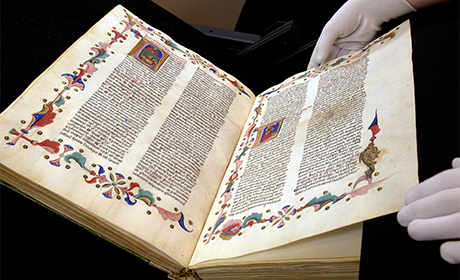The Bibliotheca Palatina

Photo: University Library Heidelberg
The origins of the Bibliotheca Palatina date back to the year 1386, when Heidelberg University was founded. Because over time it came to hold the collections of both the university and the Palatinate, the Bibliotheca Palatina represented virtually all knowledge from the Middle Ages and Early Modern Age. At its height at the beginning of the 17th century, the library was considered the “optimus Germaniae literatae thesaurus“, the greatest treasure of all Germany’s learned. It met a premature end when Heidelberg was conquered by Catholic troops during the Thirty Years’ War. Pope Gregory XV demanded the entire library, the intellectual armoury of the Protestants, as the spoils of war. After a six-month journey, 3,700 mediaeval manuscripts and 13,000 printed volumes arrived at the Biblioteca Vaticana in August 1623. It was not until 1816 that at least 847 of the German-language manuscripts were returned to their former home library. Except for a few Greek and Latin Codices, all the remaining non-German manuscripts and printed volumes lie within the vaults of the Vatican Library in Rome.
In 2001 the Heidelberg University Library had already begun using modern digital technologies to make the initial volumes of the outstanding collection available on the Internet. Since then, multiple projects have worked on the virtual reconstruction of this unique literary treasure. Initially only portions of the collection were digitised. Thanks to the generous support of Manfred Lautenschläger and his foundation, now the Latin codices in the Biblioteca Apostolica Vaticana are also available in digital form to both researchers and the interested public alike while the priceless originals remain safely in their climatised vaults in conditions ideal for their conservation. In November 2010, a field office of the University Library's Digitisation Department was set up inside the Vatican Library. The initial goal was to digitise the 133 mediaeval manuscripts of the Bibliotheca Palatina that Elector Palatine Otto Henry had once brought to Heidelberg from the monastery at Lorsch. The remaining Latin codices, approximately 1,900 in number, have been digitised since January 2012.
Depending on their size and scope, between four and seven manuscripts made their way each week from the Vatican vaults to the climatised and darkened digitisation studio, where they were photographed with a high-resolution camera. A special camera table allowed these fragile objects to be digitised directly without touching them. Heidelberg University Library even developed a software programme to keep the work seamless. The “DWork – Heidelberg Digitisation Workflow” programme allows all the individual steps to proceed automatically, from creating the metadata and generating the Internet presentation to long-term archiving. Professional image postprocessing programmes ensure that the digital facsimiles correspond as closely as possible to the originals. In 2017 alone, the digital collection was accessed nearly 2.2 million times from 172 countries.

